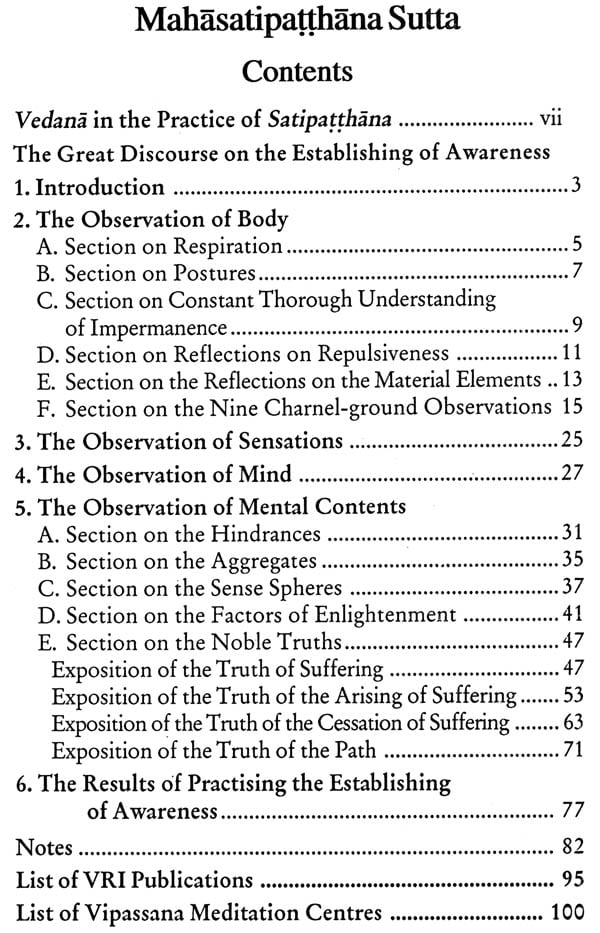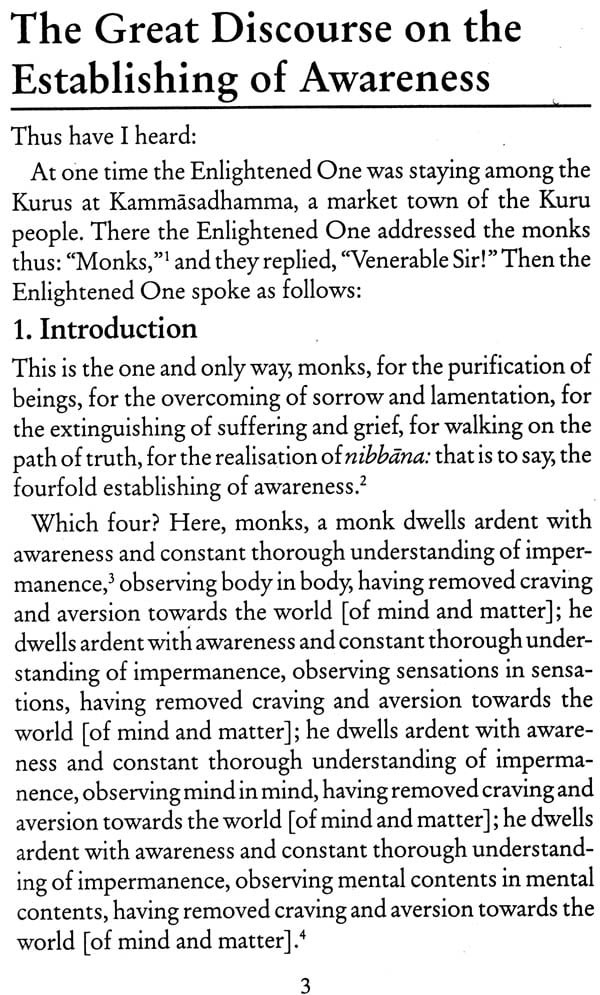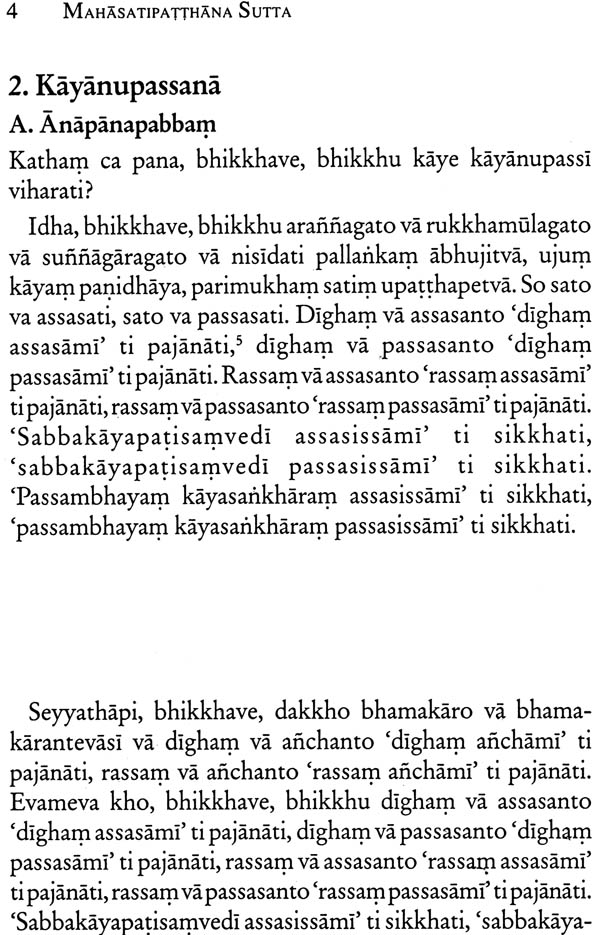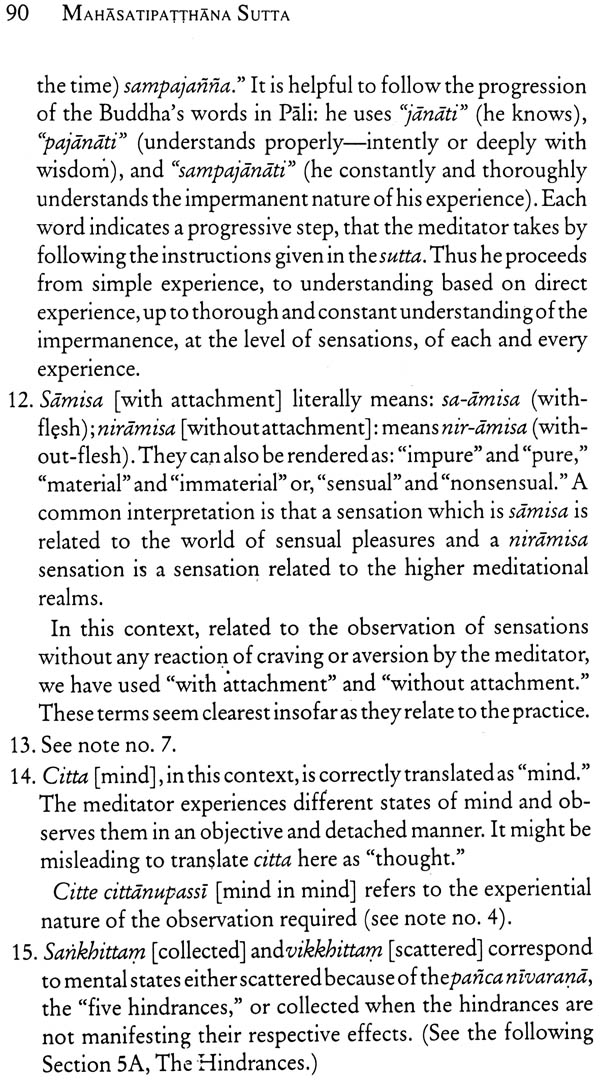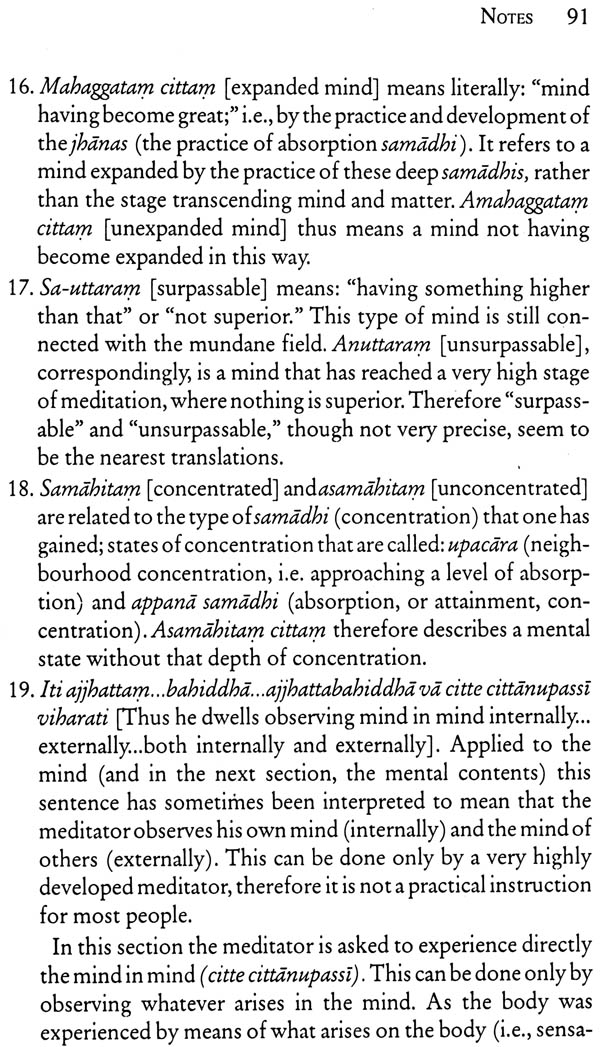
Mahasatipatthana Sutta (The Great Discourse on the Establishing of Awareness)
Book Specification
| Item Code: | NAW131 |
| Publisher: | Vipassana Research Institute |
| Language: | Pali Text With English Translation |
| Edition: | 2018 |
| ISBN: | 8174141308 |
| Pages: | 120 |
| Cover: | PAPERBACK |
| Other Details | 8.50 X 5.50 inch |
| Weight | 150 gm |
Book Description
Sri Satyanarayanji Goenka was born in Mandalay, Myanmar in 1924. Although he topped the list of all successful candidates in the whole of Myanmar in the tenth class he could not continue his studies further because of financial constraints of his family. At a very early age he set up many commercial and industrial institutions and earned fabulous wealth. He also established many social and cultural centres. Because of tension he became a victim of migraine, which could not be cured by doctors of Myanmar and of other countries in the world. Then some one suggested him to take a course of Vipassana. Vipassana has done well not only to him but it has also been benefiting many others.
He learned Vipassana from Sayagyi U Ba Khin in 1955. Sitting at the feet of his teacher he practices it for fourteen years He also studied the words of the Buddha during this period. He came to India in 1969 and conducted the first vipassana course in Mumbai. After that a series of courses were held. In 1976 the first residential course of vipassana was held in Igatpuri and the first centre of vipassana was established here. Up till now 167 centres have been established all over the world. New centres also are coming up. At these centres 1200 trained teachers teach vipassana in 59 languages of the world. Not only ten- day courses are conducted at these centres but also at some centres 20-day, 30-day, 45-day and 60-day courses are conducted. All courses are free of charge. The expenses on food and accommodation etc. are met by the self-willed Dana given by those who benefited from the course. Seeing its benevolent nature vipassana courses are held not only for the inmates of jails and school children in the world but also for police personnels, judges, government officers etc.
The practice of the four-fold satipatthana, the establishing of awareness, was highly praised by the Buddha in the suttas, Mentioning its importance in the Mahdsatipatthana Sutta, the Buddha called it ekayano maggo—the only way for the purification of beings, for Overcoming sorrow, for extinguishing suffering, for walking on the path of truth and for realising nibbang (liberation)!
In this sutta, the Buddha Presented a practical method for developing self-knowledge by means of kayanupassang (observation of the body), vedandnupassana (observation of sensations), cittanupassang (observation of the mind), and dhammanupassana (observation of the contents of the mind).
To explore the truth about ourselves, we must examine what weare: body and mind. We must learn to observe these directly within ourselves, Accordingly, we must keep three points in mind: 1) The reality of the body may be Imagined by contemplation, but to experience it directly one must work with vedang (body sensations) arising within it 2) Similarly, the actual experience of the mind is attained by working with the contents of the mind. Therefore, in the same way as body and sensations cannot be experienced separately, the mind cannot be observed apart from the contents of the mind. 3) Mind and matter are so closely inter-related that the contents of the mind always manifest themselves as sensations in the body. For this reason the Buddha said:
Vedana-samosarana sabbe dhamma.
Everything that arises in the mind flows together with sensations.
Therefore, observation of sensations offers a means — indeed the only means — to examine the totality of our being, physical as well as mental.
Broadly speaking, the Buddha refers to five types of vedana:
1. Sukha vedana — pleasant sensations
2. Dukkha vedand — unpleasant sensations
3. Somanassa vedand — pleasant mental feeling
4. Domanassa vedana — unpleasant mental feeling
5. Adukkhamasukhd vedana — neither unpleasant nor pleasant sensations.
In all references to vedana in the Satipatthana Sutta the Buddha speaks of sukha vedand, dukkha vedana, i.e., the body sensations; or adukkhamasukha vedana, which in this context also clearly denotes neutral body sensations.
The strong emphasis is on body sensations because they work as a direct avenue for the attainment of fruition (nibbana) by means of "strong dependence condition" (upanissaya-paccayena paccayo), i.e., the nearest dependent condition for our liberation. This fact 1s succinctly highlighted in the Patthana, the seventh text of Abhidhamma Pitaka under the Pakatupanissaya, where it is stated:
Kayikam sukham kayikassa sukhassa, kaytkassa dukkhassa, phalasamapattiya upantssayapaccayenapaccayo.
Kayikam dukkham kayikassa sukhassa, kayikassa dukkhassa, phalasamapattiya upanissayapaccayena paccayo.
Utu kayikassa sukhassa, kayikassa dukkhassa, phalasamapattiya upanissayapaccayena paccayo.
Bhojanam kayikassa sukhassa, kayikassa dukkhassa, phalasamapattiya upan issayapaccayena paccayo.
Sendsanam kayikassa sukhassa, kayikassa dukkhassa, phalasaméapattiya upan issayapaccayena paccayo.
Pleasant body sensation is related to pleasant sensation of the body, unpleasant sensation of the body, and attainment of fruition (nibbana) by strong dependence condition.
Unpleasant body sensation is related to pleasant sensation of the body, unpleasant ‘sensation of the body, and attainment of fruition by strong dependence condition.
The season (or surrounding environment) is related to pleasant sensation of the body, unpleasant sensation of the body, and attainment of fruition by strong dependence condition.
Food is related to pleasant sensation of the body, unpleasant sensation of the body, and attainment of fruition by strong dependence condition.
Lying down and sitting (i.e., the mattress and cushions, or the position of lying, sitting, etc.) is related to pleasant sensation of the body, unpleasant sensation of the body, and attainment of fruition by strong dependence condition.
**Sample Pages**
